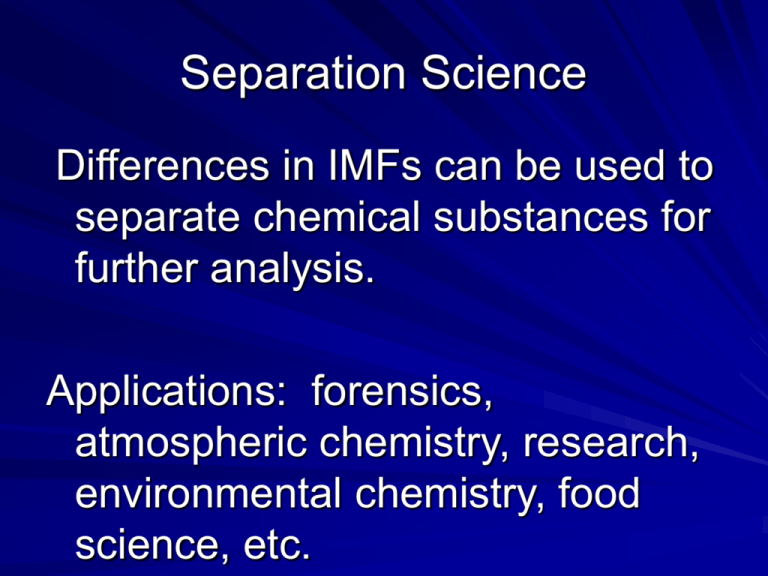Separation Science
advertisement

Separation Science Differences in IMFs can be used to separate chemical substances for further analysis. Applications: forensics, atmospheric chemistry, research, environmental chemistry, food science, etc. Separation Science How CAN we separate and identify a mixture of alkanes and their isomers? Which of these isomers of pentane has the highest boiling point? Gas Chromatography Uses differences in IMF to separate compounds and isomers. Used to determine the composition of a mixture: qualitatively (what is present) and quantitatively (how much of each component is present). Gas chromatography using modern instrumentation and columns requires only a trace of sample dissolved in a volatile solvent. Gas Chromatography A E Gas Chromatograph D B C Sample: mixture of volatile liquids (~1L) Gas Chromatogram B E C Abundance A D 0 5 10 Time (minutes) 15 20 Each substance will elute from the chromatograph after a characteristic time – and recorded on a chromatogram. Gas Chromatograph Injection Port Detector Capillary Column Data System or Recorder Carrier Gas Supply Oven Gas Chromatography (GC) A mixture (liquid or gas) is injected into a thin, heated column packed with a solid coated with a viscous liquid. The mixture vaporizes and is carried through the column by a carrier gas (generally helium). column Carrier gas + mixture Packing material covered with a viscous liquid detector Gas Chromatography (GC) Capillary Tube Liquid Stationary Phase A ABA A A A A BA B B B He Carrier gas AA B A BA B He Carrier gas A A A A B B B B B B B B 0 Immediately after injection After several minutes Compounds A and B interact with the stationary phase through intermolecular forces: (van der Waals or dipole-dipole forces, including hydrogen bonding). A interacts more strongly with the stationary liquid phase and is retained relative to B, which interacts weakly with the stationary phase. Thus B spends more time in the gas phase and advances more rapidly through the column and has a shorter retention time than A. Gas Chromatography (GC) A A A A He Carrier gas A A A A B B B B B B B A B B Time 0 After several minutes Resulting chromatogram out first out last Typically, components with similar polarity elute in order of volatility. Thus alkanes elute in order of increasing boiling points; lower boiling alkanes will have shorter retention times than higher boiling alkanes. Concept Test Which hydrocarbon has the highest boiling point? Concept Test Which hydrocarbon will come out of the GC column first? Gas Chromatograms tR = “retention time” Peak due to hexane Air peak ConcepTest Which chromatogram on the next slide is due to heptane, and which to octane? A B heptane octane octane heptane







